Investigation of Nano-Heat-Transfer Variability of AlGaN/GaN-Heterostructure-Based High-Electron-Mobility Transistors
Abstract
:1. Introduction
2. Structures and Boundary Conditions
- (1)
- The continuity of electron and hole wavefunctions at the interface is ensured by setting the values of the wavefunction and its derivatives equal on both sides of the interface.
- (2)
- The concentrations of holes and electrons are constant across the interface:
- (3)
- The electric potential at the interface (V) is constant, accounting for the built-in potential due to the difference in electron affinities and bandgaps between GaN and AlGaN.
3. Computation Model
Ballistic-Diffusive Model
4. Results and Discussion
5. Conclusions
Author Contributions
Funding
Data Availability Statement
Conflicts of Interest
References
- Pengelly, R.S.; Wood, S.M.; Milligan, J.W.; Sheppard, S.T.; Pribble, W.L. A Review of GaN on SiC High Electron-Mobility Power Transistors and MMICs. IEEE Trans. Microw. Theory Tech. 2012, 60, 1764–1783. [Google Scholar] [CrossRef]
- Meneghini, M.; Meneghesso, G.; Zanoni, E. Power GaN Devices; Springer: Cham, Switzerland, 2017. [Google Scholar]
- Peralagu, U.; Alian, A.; Putcha, V.; Khaled, A.; Rodriguez, R.; Sibaja-Hernandez, A.; Chang, S.; Simoen, E.; Zhao, S.E.; De Jaeger, B.; et al. CMOS-compatible GaN-based devices on 200 mmSi for RF applications: Integration and performance. In Proceedings of the 2019 IEEE International Electron Devices Meeting (IEDM), San Francisco, CA, USA, 9–11 December 2019; pp. 17.2.1–17.2.4. [Google Scholar]
- Karmalkar, S.; Mishra, U.K. Enhancement of breakdown voltage in AlGaN/GaN high electron mobility transistors using a field plate. IEEE Trans. Electron Devices 2001, 48, 1515. [Google Scholar] [CrossRef]
- Mishra, U.K.; Parikh, P.; Wu, Y.F. AlGaN/GaN HEMTs overview of device operation and applications. Proc. IEEE 2002, 90, 1022–1031. [Google Scholar] [CrossRef]
- Chatterjee, B.; Dundar, C.; Beechem, T.E.; Heller, E.; Kendig, D.; Kim, H.; Choi, S. Nanoscale electro-thermal interactions in AlGaN/GaN high electron mobility transistors. J. Appl. Phys. 2020, 127, 044502. [Google Scholar] [CrossRef]
- Ambacher, O.; Smart, J.; Shealy, J.R.; Weimann, N.G.; Chu, K.; Murphy, M.; Schaff, W.J.; Eastman, L.F.; Dimitrov, R.; Wittmer, L. Two-dimensional electron gases induced by spontaneous and piezoelectric polarization charges in N-and Gaface AlGaN/GaN heterostructures. J. Appl. Phys. 1999, 85, 3222–3323. [Google Scholar] [CrossRef]
- Siemens, M.E.; Li, Q.; Yang, R.; Nelson, K.A.; Anderson, E.H.; Murnane, M.M.; Kapteyn, H.C. Quasi-ballistic thermal transport from nanoscale interfaces observed using ultrafast coherent soft X-ray beams. Nat. Mater. 2010, 9, 26–30. [Google Scholar] [CrossRef]
- McAlister, S.P.; Bardwell, J.A.; Haffouz, S.; Tang, H. Self-heating and the temperature dependence of the dc characteristics of GaN heterostructure field effect transistors. J. Vac. Sci. Technol. A 2006, 24, 624–628. [Google Scholar] [CrossRef]
- Meneghesso, G.; Verzellesi, G.; Danesin, F.; Rampazzo, F.; Zanon, F.; Tazzoli, A.; Meneghini, M.; Zanoni, E. Reliability of GaN high-electron-mobility transistors: State of the art and perspectives. IEEE Trans. Device Mater. Reliab. 2008, 8, 332–343. [Google Scholar] [CrossRef]
- Luo, X.; Halder, S.; Curtice, W.R.; Hwang, J.C.; Chabak, K.D.; Walker, D.E.; Dabiran, A.M. Scaling and high-frequency performance of AlN/GaN HEMTs. In Proceedings of the 2011 IEEE International Symposium on Radio-Frequency Integration Technology, Piscataway, NJ, USA, 30 November–2 December 2011; pp. 209–212. [Google Scholar] [CrossRef]
- Rosker, M.; Bozada, C.; Dietrich, H.; Hung, A.; Via, D.; Binari, S.; Vivierios, E.; Cohen, E.; Hodiak, J. The DARPA wide band gap semiconductors for RF applications (WBGS-RF) program: Phase II results. In Proceedings of the International Conference on Compound Semiconductor Manufacturing Technology, Tampa, FL, USA, 18–21 May 2009. [Google Scholar]
- Rezgui, H.; Nasri, F.; Ali, A.B.H.; Guizani, A.A. Analysis of the ultrafast transient heat transport in sub 7-nm SOI FinFETs technology nodes using phonon hydrodynamic equation. IEEE Trans. Electron Devices 2020, 68, 10–16. [Google Scholar] [CrossRef]
- Hua, Y.C.; Li, H.L.; Cao, B.Y. Thermal spreading resistance in ballistic-diffusive regime for GaN HEMTs. IEEE Trans. Electron Devices 2019, 66, 3296–3301. [Google Scholar] [CrossRef]
- Rezgui, H.; Nasri, F.; Nastasi, G.; Aissa, M.F.B.; Rahmouni, S.; Romano, V.; Belmabrouk, H.; Guizani, A.A. Design optimization of nanoscale electrothermal transport in 10 nm SOI FinFET technology node. J. Phys. D Appl. Phys. 2020, 53, 495103. [Google Scholar] [CrossRef]
- Azarifar, M.; Doğacan, K.A.R.A.; Dönmezer, N. Thermal Spreading Performance of Gan-On-Diamond Substrate HEMTs With Localized Joule Heating. J. Therm. Sci. Technol. 2019, 39, 111–119. [Google Scholar]
- Donmezer, N.; Islam, M.; Yoder, P.D.; Graham, S. The impact of nongray thermal transport on the temperature of AlGaN/GaN HFETs. IEEE Trans. Electron. Devices 2015, 62, 2437–2444. [Google Scholar] [CrossRef]
- Bertoluzza, F.; Delmonte, N.; Menozzi, R. Three-dimensional finite-element thermal simulation of GaN-based HEMTs. Microelectron. Reliab. 2009, 49, 468–473. [Google Scholar] [CrossRef]
- Bao, H.; Chen, J.; Gu, X.; Cao, B.-Y. A review of simulation methods in micro/nanoscale heat conduction. ES Energy Environ. 2018, 1, 16–55. [Google Scholar] [CrossRef]
- Guo, Z.-Y. Energy-mass duality of heat and its applications. ES Energy Environ. 2018, 1, 4–15. [Google Scholar] [CrossRef]
- Hua, Y.-C.; Cao, B.-Y. Ballistic-diffusive heat conduction in multiply-constrained nanostructures. Int. J. Therm. Sci. 2016, 101, 126–132. [Google Scholar] [CrossRef]
- Yalamarthy, A.S.; So, H.; Muñoz Rojo, M.; Suria, A.J.; Xu, X.; Pop, E.; Senesky, D.G. Tuning electrical and thermal transport in AlGaN/GaN heterostructures via buffer layer engineering. Adv. Funct. Mater. 2018, 28, 1705823. [Google Scholar] [CrossRef]
- Hao, Q.; Zhao, H.; Xiao, Y.; Kronenfeld, M.B. Electrothermal studies of GaN-based high electron mobility transistors with improved thermal designs. Int. J. Heat Mass Transf. 2018, 116, 496–506. [Google Scholar] [CrossRef]
- Freedman, J.P.; Leach, J.H.; Preble, E.A.; Sitar, Z.; Davis, R.F.; Malen, J.A. Universal phonon mean free path spectra in crystalline semiconductors at high temperature. Sci. Rep. 2013, 3, 2963. [Google Scholar] [CrossRef]
- Park, K.; Bayram, C. Impact of dislocations on the thermal conductivity of gallium nitride studied by time-domain thermoreflectance. J. Appl. Phys. 2019, 126, 185103. [Google Scholar] [CrossRef]
- Liu, W.; Balandin, A.A. Thermal conduction in AlxGa1-xN alloys and thin films. J. Appl. Phys. 2005, 97, 073710. [Google Scholar] [CrossRef]
- Lisesivdin, S.B.; Yildiz, A.; Et Kasap, M. Optimization of alloy composition, interlayer and barrier thicknesses in AlxGa1-xN/(AlN)/GaN high electron mobility transistors. Strain 2007, 10, 35. [Google Scholar]
- Gurusinghe, M.N.; Davidsson, S.K.; Andersson, T.G. Two-dimensional electron mobility limitation mechanisms in AlxGa1-xN/GaN heterostructures. Phys. Rev. B 2005, 72, 045316. [Google Scholar] [CrossRef]
- Liu, B.; Lu, Y.W.; Jin, G.R.; Zhao, Y.; Wang, X.L.; Zhu, Q.S.; Wang, Z.G. Surface roughness scattering in two dimensional electron gas channel. Appl. Phys. Lett. 2010, 97, 262111. [Google Scholar] [CrossRef]
- Zhang, J.; Hao, Y.; Zhang, J.; Ni, J. The mobility of two-dimensional electron gas in AlGaN/GaN heterostructures with varied Al content. Sci. China Ser. F Inf. Sci. 2008, 51, 780–789. [Google Scholar] [CrossRef]
- Chen, G. Ballistic-diffusive heat conduction equations. Phys. Rev Lett. 2001, 86, 2297. [Google Scholar] [CrossRef]
- Chen, G. Ballistic-diffusive equations for transient heat conduction from nano to macroscales. J. Heat Transfer. 2002, 124, 320–328. [Google Scholar] [CrossRef]
- Rezgui, H.; Nasri, F.; Aissa, M.F.B.; Belmabrouk, H.; Guizani, A.A. Modeling the thermal performance of nano-GNRFET transistors using ballistic-diffusive equation. IEEE Trans. Electron Devices 2018, 65, 1611–1616. [Google Scholar] [CrossRef]
- Mitterhuber, L.; Hammer, R.; Dengg, T.; Spitaler, J. Thermal characterization and modelling of AlGaN-GaN multilayer structures for HEMT applications. Energies 2020, 13, 2363. [Google Scholar] [CrossRef]
- Romano, V.; Rusakov, A. 2d numerical simulations of an electron–phonon hydrodynamical model based on the maximum entropy principle. Comput. Methods Appl. Mech. Eng. 2010, 199, 2741–2751. [Google Scholar] [CrossRef]
- Lombardi, C.; Manzini, S.; Saporito, A.; Vanzi, M. A physically based mobility model for numerical simulation of nonplanar devices. IEEE Trans. Comput.-Aided Des. Integr. Circuits Syst. 1988, 7, 1164–1171. [Google Scholar] [CrossRef]
- Du, J.; Yan, H.; Yin, C.; Feng, Z.; Dun, S.; Yu, Q. Simulation and characterization of millimeter-wave InAlN/GaN high electron mobility transistors using Lombardi mobility model. J. Appl. Phys. 2014, 115, 164510. [Google Scholar] [CrossRef]
- Device Simulation Software. In ATLAS User’s Manual; SILVACO International: Santa Clara, CA, USA, 1998; Volume II, pp. 567–1000.
- Tzou, D.Y. Macro- to Microscale Heat Transfer: The Lagging Behavior; Taylor & Francis: Washington, DC, USA, 1997. [Google Scholar]
- Ordonez-Miranda, J.; Yang, R.; Alvarado-Gil, J.J. A constitutive equation for nano-to-macro-scale heat conduction based on the Boltzmann transport equation. J. Appl. Phys. 2011, 109, 084319. [Google Scholar] [CrossRef]
- Minnich, A.J.; Chen, G.; Mansoor, S.; Yilbas, B.S. Quasiballistic heat transfer studied using the frequency-dependent Boltzmann transport equation. Phys. Rev. B 2011, 84, 235207. [Google Scholar] [CrossRef]
- Chen, G. Non-Fourier phonon heat conduction at the microscale and nanoscale. Nat. Rev. Phys. 2021, 3, 555–569. [Google Scholar] [CrossRef]
- Dong, Y.; Cao, B.Y.; Guo, Z.Y. Ballistic–diffusive phonon transport and size induced anisotropy of thermal conductivity of silicon nanofilms. Phys. E Low-Dimens. Syst. Nanostructures 2015, 66, 1–6. [Google Scholar] [CrossRef]
- Rezgui, H.; Nasri, F.; Aissa, M.F.B.; Blaabjerg, F.; Belmabrouk, H.; Guizani, A.A. Investigation of heat transport across Ge/Si interface using an enhanced ballistic-diffusive model. Superlattices Microstruct. 2018, 124, 218–230. [Google Scholar] [CrossRef]
- Lucchesi, C.; Vaillon, R.; Chapuis, P.O. Temperature dependence of near-field radiative heat transfer above room temperature. Mater. Today Phys. 2021, 21, 100562. [Google Scholar] [CrossRef]
- Klemens, P.G.; White, G.K.; Tainsh, R.J. Scattering of lattice waves by point defects. Philos. Mag. 1962, 7, 1323–1335. [Google Scholar] [CrossRef]
- Wang, Z.; Alaniz, J.E.; Jang, W.; Garay, J.E.; Dames, C. Thermal conductivity of nanocrystalline silicon: Importance of grain size and frequency-dependent mean free paths. Nano Lett. 2011, 11, 2206–2213. [Google Scholar] [CrossRef] [PubMed]
- Jang, K.W.; Hwang, I.T.; Kim, H.J.; Lee, S.H.; Lim, J.W.; Kim, H.S. Thermal analysis and operational characteristics of an AlGaN/GaN High electron mobility transistor with copper-filled structures: A simulation study. Micromachines 2019, 11, 53. [Google Scholar] [CrossRef] [PubMed]
- Peierls, R. Zur kinetischen Theorie der Wärmeleitung in Kristallen. Ann. Phys. 1929, 395, 1055–1101. [Google Scholar] [CrossRef]


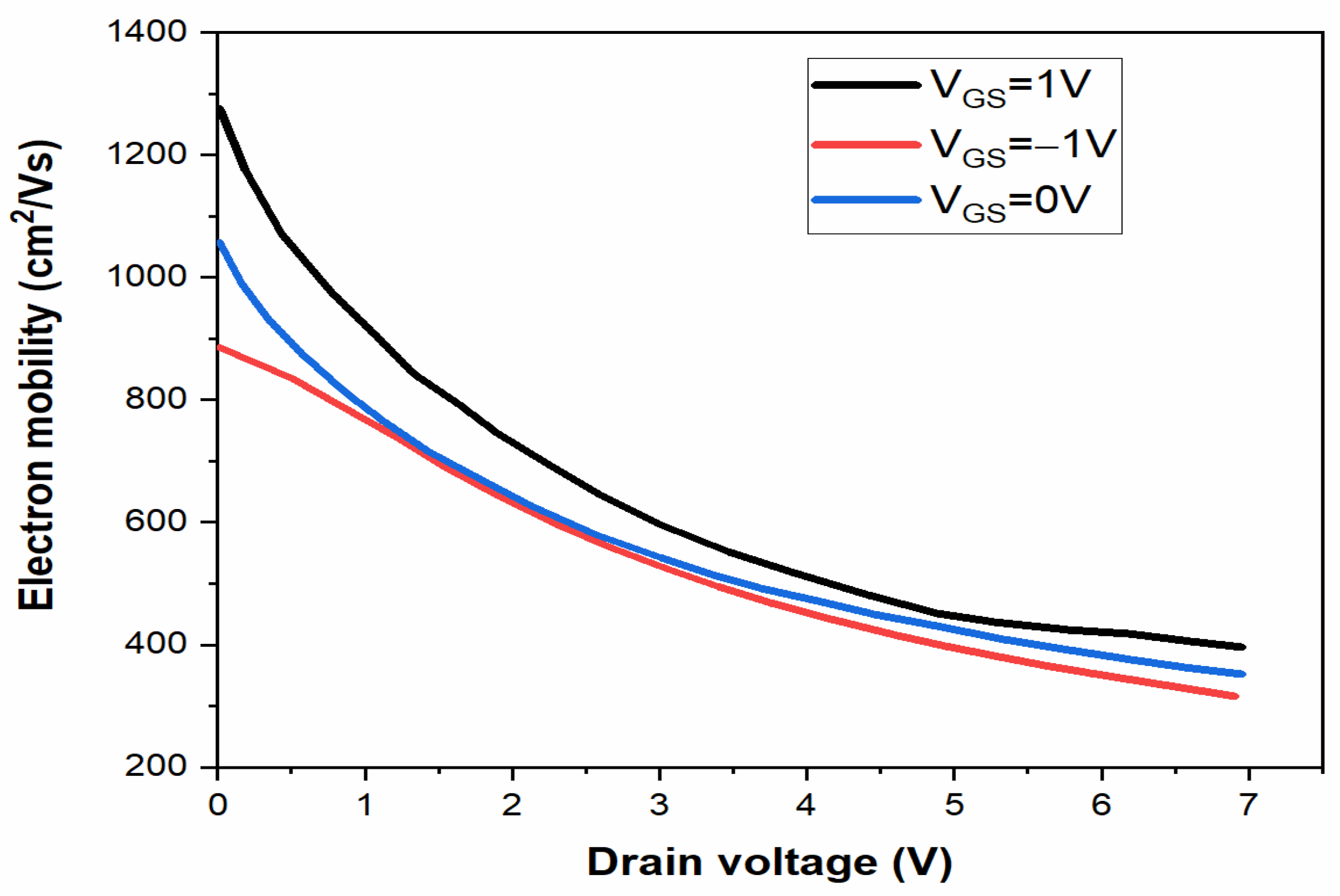


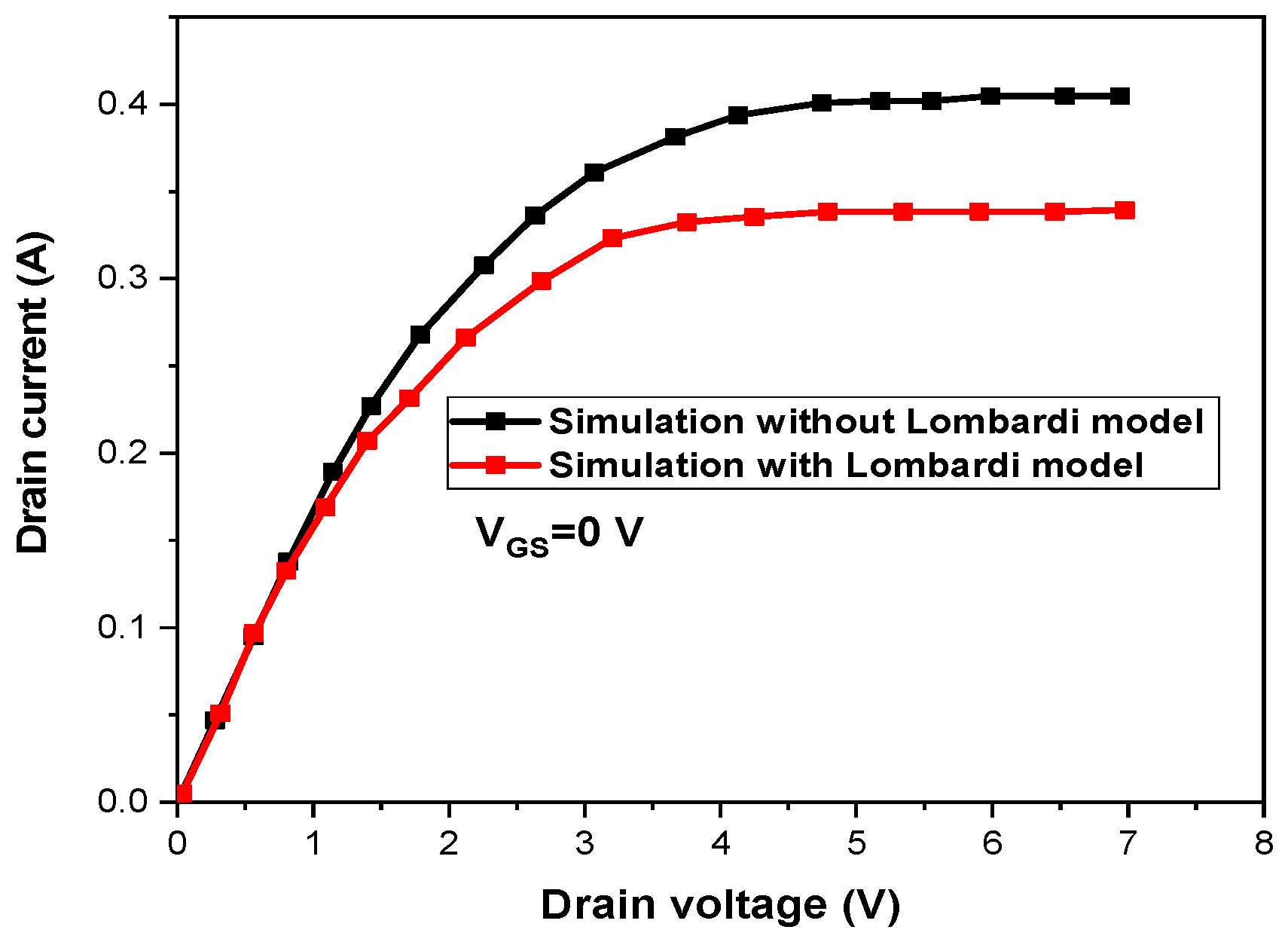
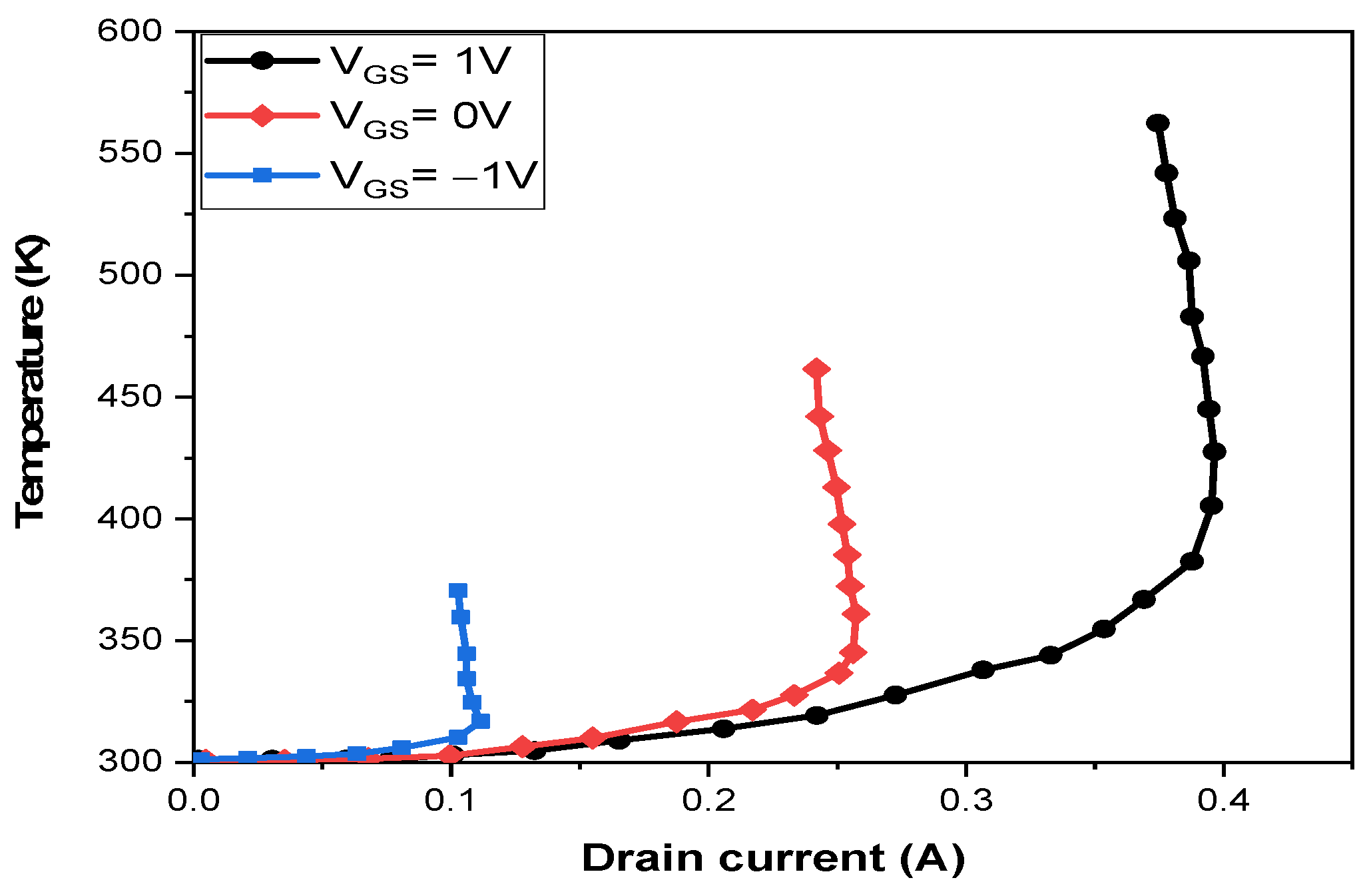

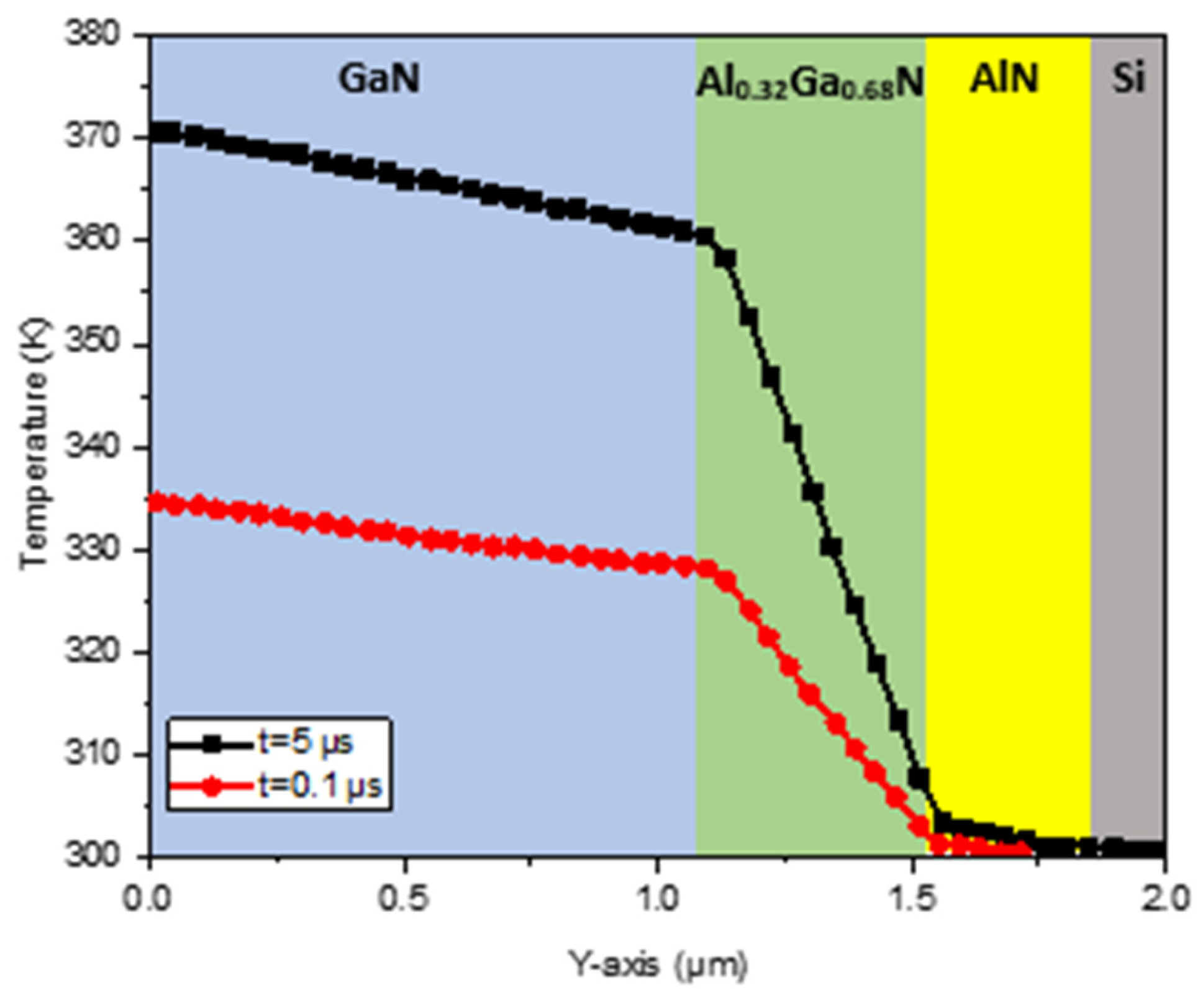
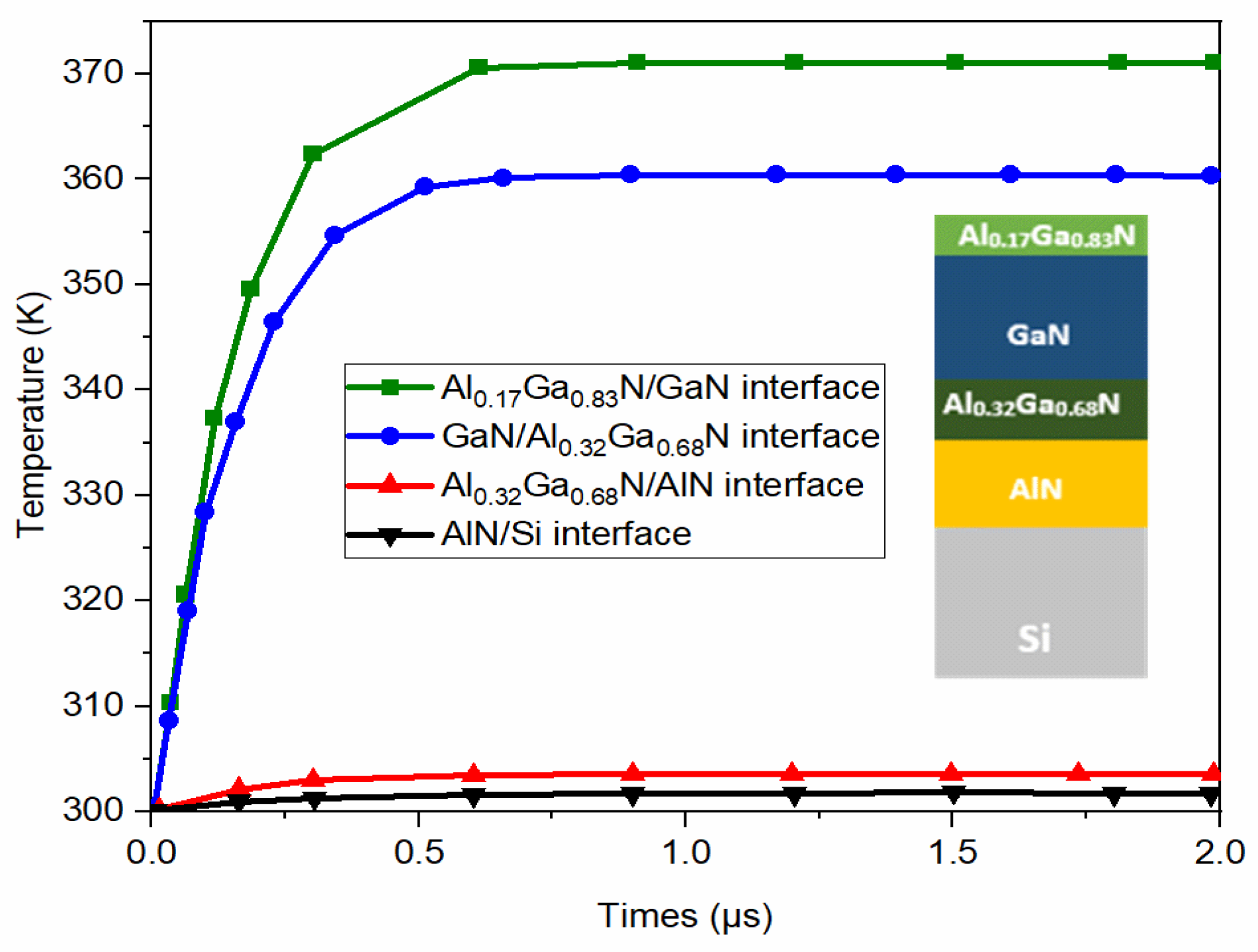


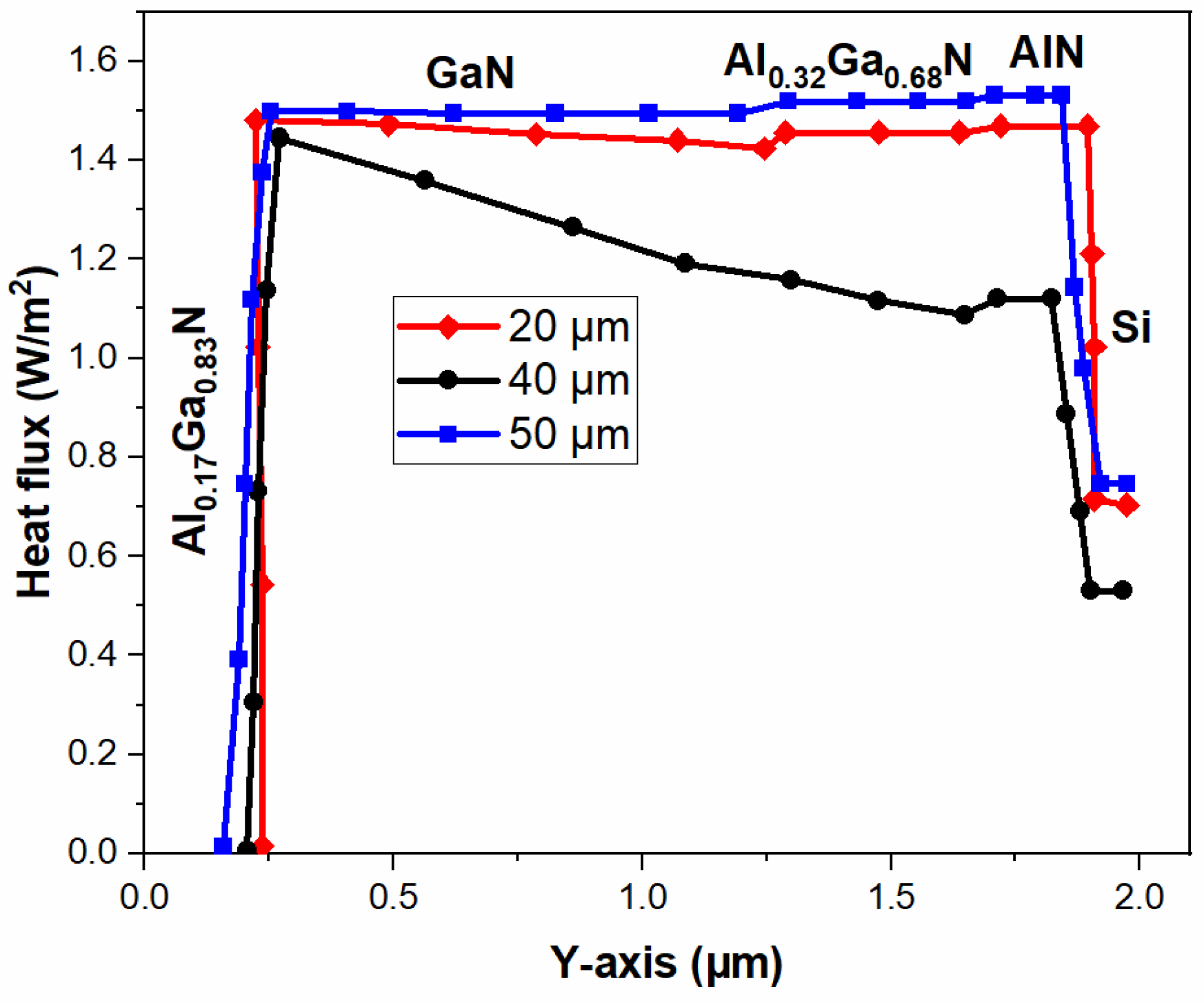
| Si | 3000 | 150 | 1.5 |
| AlN | 7228.24 | 130 | 2.67 |
| GaN | 4997.5 | 220 | 2.63 |
| Al0.32Ga0.68N | 5899.06 | 9.7 | 2.65 |
| Al0.17Ga0.83N | 5899.06 | 11.4 | 2.65 |
| 0.065 | −1.5 | −0.2 |
| Materials | Parameter |
|---|---|
| GaN | −1.84 ± 0.05 |
| AlN | −1.8 ± 0.07 |
| Al0.17Ga0.68N | −0.27 ± 0.007 |
| Al0.32Ga0.68N | −0.25 ± 0.007 |
| Materials | Callaway Model | BVK Model | ||||
|---|---|---|---|---|---|---|
| AlN | 3 | 10−4 | 0.4 | 3.8 | 10−5 | 0.3 |
| GaN | 3 | 10−4 | 1 | 0.8 | 10−5 | 1 |
| Al0.32Ga0.67N | 3 | 0.056 | 1 | 3 | 0.4 | 1 |
| Al0.17Ga0.83N | 3 | 0.03 | 0.85 | 3 | 0.2 | 0.96 |
Disclaimer/Publisher’s Note: The statements, opinions and data contained in all publications are solely those of the individual author(s) and contributor(s) and not of MDPI and/or the editor(s). MDPI and/or the editor(s) disclaim responsibility for any injury to people or property resulting from any ideas, methods, instructions or products referred to in the content. |
© 2023 by the authors. Licensee MDPI, Basel, Switzerland. This article is an open access article distributed under the terms and conditions of the Creative Commons Attribution (CC BY) license (https://creativecommons.org/licenses/by/4.0/).
Share and Cite
Mzoughi, H.; Nasri, F.; Almoneef, M.; Soltani, S.; Mbarek, M.; Guizani, A. Investigation of Nano-Heat-Transfer Variability of AlGaN/GaN-Heterostructure-Based High-Electron-Mobility Transistors. Electronics 2024, 13, 164. https://doi.org/10.3390/electronics13010164
Mzoughi H, Nasri F, Almoneef M, Soltani S, Mbarek M, Guizani A. Investigation of Nano-Heat-Transfer Variability of AlGaN/GaN-Heterostructure-Based High-Electron-Mobility Transistors. Electronics. 2024; 13(1):164. https://doi.org/10.3390/electronics13010164
Chicago/Turabian StyleMzoughi, Haikel, Faouzi Nasri, Maha Almoneef, Sonia Soltani, Mohamed Mbarek, and Amenallah Guizani. 2024. "Investigation of Nano-Heat-Transfer Variability of AlGaN/GaN-Heterostructure-Based High-Electron-Mobility Transistors" Electronics 13, no. 1: 164. https://doi.org/10.3390/electronics13010164






